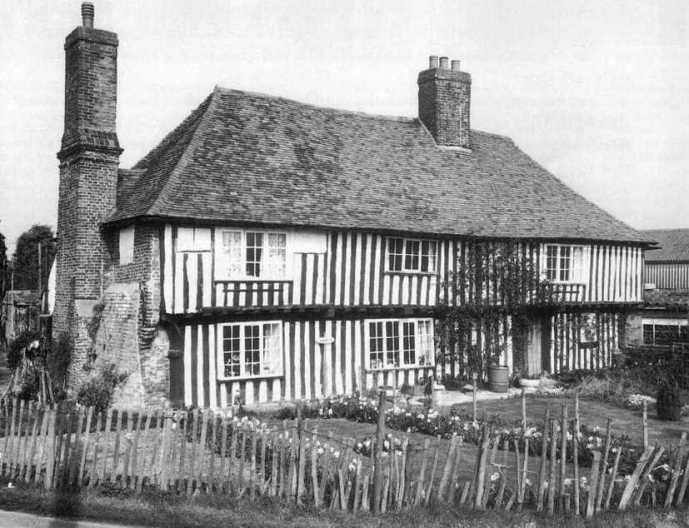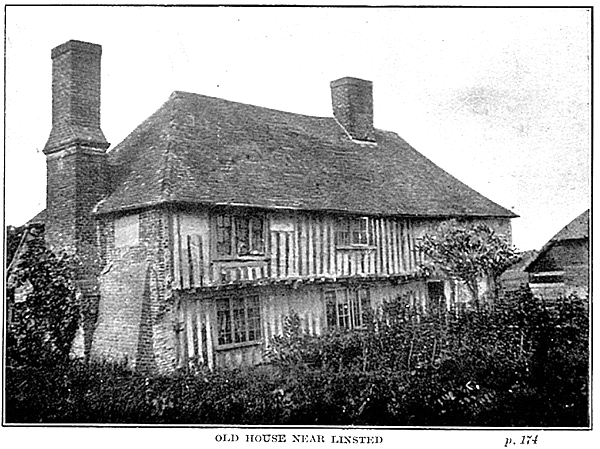Sunderland Farmhouse - also "Sundries"
Elizabeth Selby identifies three names for this farmhouse - "Sunderland", Sundries and (in the time of Reverend Henry Eve) "Edwards". She also speculates "Sundrise" and, possibly "Saundre's Farm". The building sits on Claxfield Lane/Mill Lane - the name of this lane changes depending on which end you enter it! The southern end of the lane sits next to Berkeley House. This house was once called Mill House as it once contained a steam-driven mill; it also has the remains of a windmill in its grounds - Champion's Mill. Further north, the lane also once contained a "Union Mill" (a tarred smock mill that was destroyed in a storm in 1870) that was erected by local farmers to process their grain.

This is an example of a timber framed, 16th century house with a continuous jetty. This indicates that the house was built with a ceiling throughout the ground floor. This is a more advanced design than the 'hall-house' (ceiled at both ends, but not in the central hall) or the house with a small smoke bay open to the rafters, but otherwise ceiled. The fires were contained in chimneys from the start.
Acknowledgement: Picture reproduced, and interpretation taken, with permission, from: The House Within. Interpreting Mediaeval Houses of Kent, P S Barnwell and A T Adams, 1994. Royal Commission on the Historical Monuments of England. Crown Copyright. Drafted by Bob Baxter.
Additional Research
 This Grade II* listed farmhouse is currently split into two residences.
This Grade II* listed farmhouse is currently split into two residences.
Additional Research (October 2010) was provided by Nigel Heriz-Smith, in response to a question from a family researcher (Christine Bennett) who was looking for clues to the whereabouts of her ancestors, the Goldsmith Family, we dug into Elizabeth Selby's excellent "Teynham Manor and Hundred" in which she suggests a potential connection to Richard Saundre from the 14th Century. This helps us make sense of the handwritten entry in the 1841 census for properties along what is now Mill Lane/Claxfield Lane.
Selby tells us in 1935: [p.70] "SUNDRIES, another 15th century house on the estate [SEWARDS or LYNSTED LODGE estate], was later known as Edwards. It is a fine old house with traces of a centre hall and screens intact. Wallenberg connects the name with Richard Saundre mentioned in a Feet of Fines of 1365."
In describing Teynham Church [p21] Selby says: "THE CHANTRY: A Chantry was established in 1401; a full account of this will be found in the book on Kent Chantries recently published by Mr. Hussey
It was named "Chantry of Richard Saundre" and dedicated in honour of Holy Trinity, S. Mary, S. Nicholas and All Saints. A licence was given to Richard Colyer and Robert atte Berghe by Henry IV and the Archbishop to found this Chantry.The Chaplain was to celebrate daily at the Alter of S. Nicholas for the souls of Michael de S. Quintin, Robert at Berghe, John Roper, Richard Colyer and Richard Saundre, the founders of the Chantry, and all their benefactors, parents, ancestors and of all the parishioners there." [Ref: At Berghe, pp.115, 116; John Roper, p.66; Colyer, 68; Saundre, 70.].
Further References to Sunderland and Jeffries on Claxfield Lane can also be found in Charles Igglesworth's "A Saunter through Kent" (Lynsted Chapter)
Kent Historic Environment Record
HER Number: TQ 96 SW 1216
Summary: Grade II* listed building. Main construction periods 1500 to 1599
Summary from record TQ 96 SW 48: Sunderland Farmhouse, formerly known as Sundries, is an unrestored 16th century building with the whole of the first floor overhanging. It is timber framed with plaster and brick infill. A fireplace is dated 1657.
Grid Reference: TQ 94259 61657
TQ 96 SW LYNSTED CLAXFIELD ROAD (south side)
2/49 Nos.1+2 Sunderland Farmhouse - 27.8.52 II*
House, now 2 cottages. C16. Timber framed, exposed close studding with plaster infill, with plain tiled roof. Left return front rebuilt C17 with red brick in English bond. Lobby entry plan of 4 framed bays. Two storeys with continuous jetty on dragon posts. Hipped roof with stacks to centre right and projecting and offset at end left. Three wood casements to first floor with 3 blocked window openings, and 2 oriel windows on ground floor, with blocked opening to right. Plank and stud door to centre right in moulded four-centred arched surround. Catslide outshot to rear. Interior: fireplace dated 1675. Selby notes traces of central hall and screens passage. (See E. Selby, Teynham Manor and Hundred, 1982 edn. p.70).
Listing NGR: TQ9426361664
Description from record TQ 96 SW 48: [Name centred TQ 9433 6166] Sundries [NAT] (1) On the Sittingbourne road from Lynsted stands Sundries or Sundrise, known today as Sunderland Farm and belonging to Mr Mercer. A fireplace in one of the rooms bears the date 1657, and in the spandrels of the original oak doorway are carved Tudor roses. The house is of timber work filled with white plaster, and of red brick. It is long and flat-fronted with the ends of the first storey beams protruding and with rough hewn, solid corner posts. Windows, however,are modern. (2) "Sundries" (confirmed by tenant) now two dwellings, is in fair condition. There is early brick and a large external chimney stack at the south end of the cottage. Two original windows, now blocked, in the east front. GP/AO/59/196/7 from S.E. (3) Owner reaffirmed that name is Sunderland and not Sundries. (4) [TQ 9425 6166] Sunderland: re-investigated, as described above. (5) [TQ 9426 6165] Sunderland [NR] (6) No.s 1 and 2 Sunderland Farmhouse, Grade II*, Claxfield Road (south side). House, now two cottages. 16th century. (For full description see list.) (7) Sunderland, an unrestored 16th century building, with the whole of the first floor overhanging. (8)
Sources and further reading: Scheduling record: English Heritage. List of Buildings of Special Architectural or Historic Interest.
- Unpublished document: OS Card / NAR index entry. OS 6" 1909.
- Unpublished document: OS Card / NAR index entry. A Saunter through Kent 22 1928 59-60 illust (C Igglesden).
- Unpublished document: OS Card / NAR index entry. F1 ASP 10-JUL-59.
- Unpublished document: OS Card / NAR index entry. Mr P French (Owner).
- Unpublished document: OS Card / NAR index entry. OS 513 (H G Smith 2 5 61).
- Unpublished document: OS Card / NAR index entry. F2 AC 11-JUL-63.
- Unpublished document: OS Card / NAR index entry. Teynham Manor and Hundred 1982 70 (E Selby).
- Unpublished document: OS Card / NAR index entry. DOE (HHR) Kent Boro of Swale 21 March 1985 20.
- Unpublished document: OS Card / NAR index entry. The Buildings of England North East and East Kent 1983 380 (J Newman ed N Pevsner).
- Bibliographic reference: Field report for monument TQ 96 SW 48 - July, 1959.
- Bibliographic reference: Field Report for Monument TQ 96 SW 48 - July, 1963.
Sunderland Farmstead - Courtyard remains
HER Number: MKE85465
A loose courtyard plan farmstead with buildings to three sides of the yard.
Grid Reference: TQ 9426 6167
Map Sheet: TQ96SW
Parish: LYNSTED WITH KINGSDOWN, SWALE, KENT
Monument Types
FARMSTEAD (Post Medieval - 1540 AD to 1540 AD)
Loose courtyard with working agricultural buildings on three sides and with additional detached elements to the main plan
Farmhouse: Farmhouse detached in central position
Position: Isolated position
Survivial: Altered - significant loss of original form (more than 50%)
New sheds: Large modern sheds built on the site of the historic farmstead, may have destroyed original buildings or obscured them. (1-2)
Sources
- Forum Heritage Services, 2012, Kent Farmsteads & Landscape Project (Unpublished document)
- English Heritage, 2009, Historic Farmsteads: A Manual for Mapping (Unpublished document)
